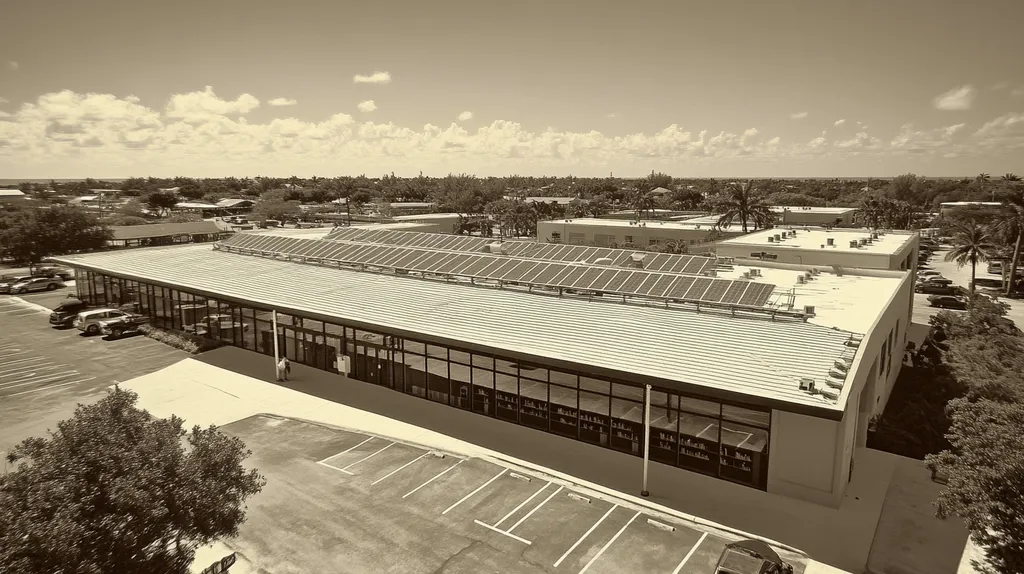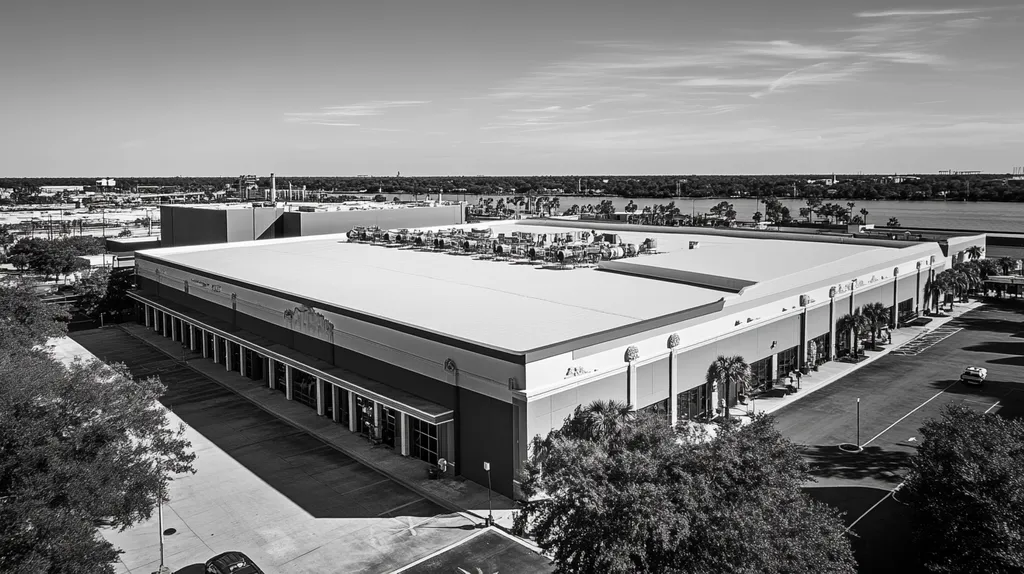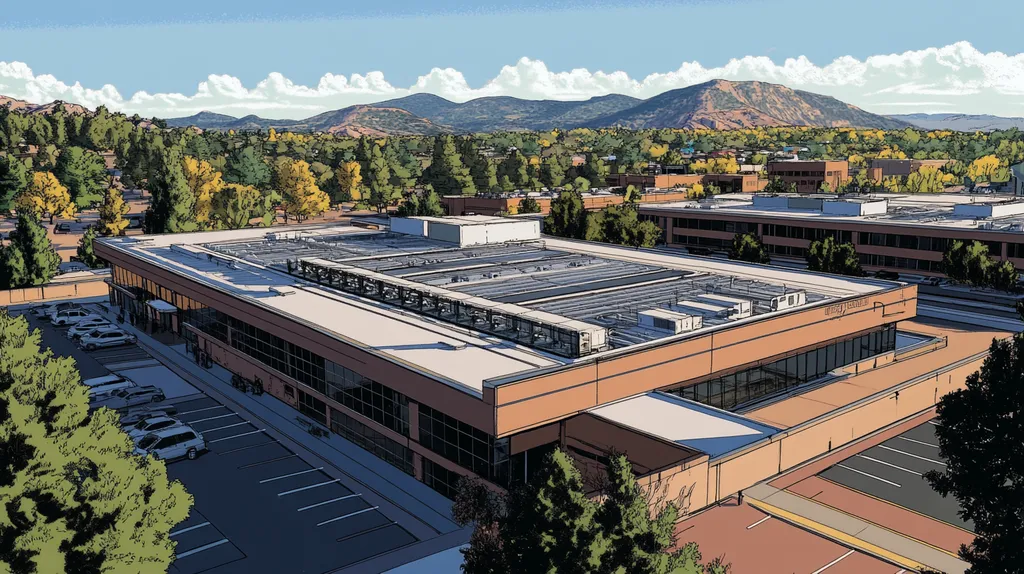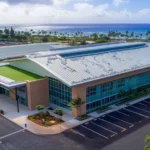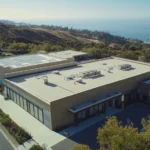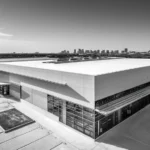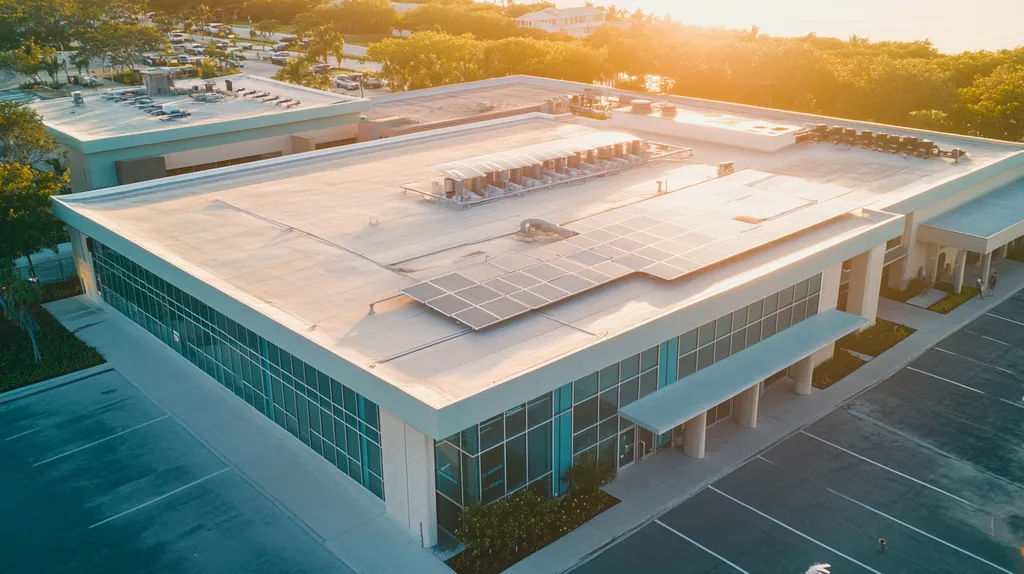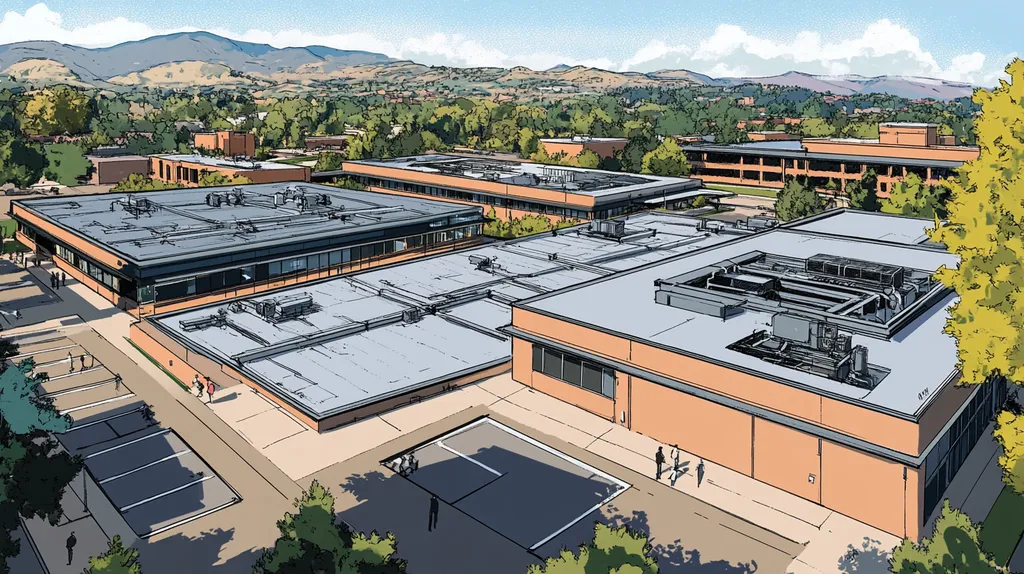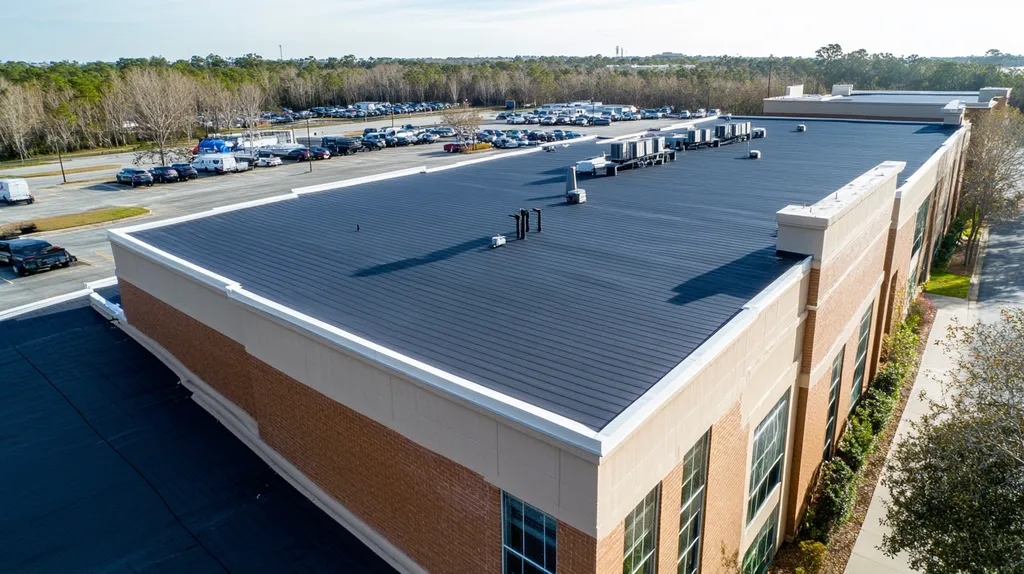Every year, commercial building owners lose millions in preventable water damage due to poorly managed roof drainage systems. Studies show that up to 90% of premature roof failures stem from water-related issues, with coating selection playing a critical yet often overlooked role.
The relationship between roof coatings and drainage systems determines whether water flows safely off a structure or creates devastating ponding conditions. Modern coating technologies offer promising solutions, but only when properly matched to existing drainage configurations.
This comprehensive guide examines how coatings impact commercial roof drainage, exploring everything from basic principles to advanced applications that protect valuable building assets.
SECTION 1: THE BASICS EXPLAINED
Every year, commercial building owners lose millions of dollars due to drainage-related roofing failures. Water accumulation from improper drainage can reduce a roof’s lifespan by up to 50% and lead to catastrophic structural damage. Modern roof coatings play a vital role in drainage system performance, yet many facility managers overlook their impact when planning maintenance strategies.
What It Is (In Plain Language)
Roof coatings are specialized liquid membranes that create a seamless, protective layer over existing roofing materials. These coatings work with drainage systems to direct water away from the roof surface efficiently.
While roof coatings can enhance protection against leaks and ponding water, they should not be viewed as a replacement for proper drainage systems. Instead, they function as part of an integrated approach to water management. (source: SmartSeal)
The coating’s thickness, texture, and application method all influence how water moves across the roof surface. Even minor variations in coating application can create low spots where water collects, potentially compromising the entire drainage system.
Understanding this relationship between coatings and drainage helps facility managers make informed decisions about roof maintenance and repairs.
Why It Matters (To Your Building)
Proper coating selection and application directly impact a building’s drainage efficiency. When water doesn’t drain properly, it can add thousands of pounds of excess weight to the roof structure.
Standing water accelerates the deterioration of roofing materials and can void manufacturer warranties. Just one inch of standing water on a 1,000-square-foot section adds over 5,000 pounds of stress to the building structure.
Energy costs also rise when drainage issues exist, as wet insulation loses much of its thermal resistance. This leads to higher heating and cooling expenses throughout the year.
Regular maintenance becomes more challenging and expensive when drainage problems persist, often requiring specialized equipment and additional safety measures.
How It Works
Effective roof coatings create a uniform surface that promotes consistent water flow toward drainage points. The coating’s surface tension and texture work together to guide water along predetermined paths.
Modern coating systems include subtle slope-building properties that can help correct minor drainage issues. These properties ensure water moves steadily toward drains rather than collecting in low spots.
Temperature fluctuations cause roofing materials to expand and contract. Quality coatings flex with these movements while maintaining their water-guiding properties.
The coating’s reflective properties also play a role, as they help maintain consistent roof temperatures. This reduces thermal stress and prevents warping that could disrupt drainage patterns.
SECTION 2: PRACTICAL APPLICATIONS
Commercial roof drainage challenges cost building owners millions annually in preventable damage. Proper coating selection and application timing can mean the difference between effective water management and catastrophic failure. Studies show that water-related roof damage accounts for over 40% of commercial building maintenance expenses, making practical coating knowledge essential for facility managers.
Common Uses & Examples
Low-slope and flat commercial roofs require specialized attention to drainage concerns, as these surfaces don’t naturally shed water like steeper pitches. Coatings play a vital role in protecting these vulnerable surfaces and managing water flow effectively. (source: Stutzman & Kropf)
Elastomeric coatings create seamless waterproof barriers that prevent water infiltration while directing flow to drainage points. These coatings can bridge small cracks and maintain flexibility through temperature changes, ensuring consistent performance.
Silicone-based coatings excel in areas with frequent rainfall or ponding concerns. Their natural water resistance and durability make them ideal for protecting problem areas around HVAC units and other roof penetrations.
Acrylic coatings provide excellent UV protection while enhancing water flow patterns. Their reflective properties help maintain consistent roof temperatures, reducing thermal stress that can disrupt drainage patterns.
When You Need It Most
Timing coating applications properly maximizes their effectiveness in supporting drainage systems. The most critical period is before the onset of rainy seasons when roofs face their greatest water management challenges.
After completing repairs or modifications to existing drainage systems, immediate coating application helps seal and protect the work. This prevents water infiltration at vulnerable connection points and transitions.
Buildings in regions experiencing extreme temperature fluctuations benefit from seasonal coating assessments. These evaluations help identify areas where thermal stress may have compromised drainage effectiveness.
Aging roofs approaching warranty expiration often require coating attention to maintain proper drainage function. Early intervention can extend system life and prevent costly emergency repairs.
Interactions With Other Systems
Coatings must work in harmony with existing drainage components to achieve optimal performance. This includes maintaining proper flow patterns to drains, scuppers, and downspouts without creating dam effects that trap water.
HVAC systems and roof penetrations require special coating consideration to prevent water accumulation. Proper detailing around these elements ensures continuous drainage while protecting critical connection points.
Building expansion joints and material transitions need careful coating application to maintain water flow. These areas often experience movement that can compromise drainage if not properly addressed.
Insulation systems interact directly with coatings to influence drainage performance. Proper coordination between these components prevents condensation issues while maintaining intended water flow patterns.
SECTION 3: KEY TERMINOLOGY DECODED
Commercial roofing terminology can make the difference between successful water management and costly failures. Industry studies show that misunderstandings about coating and drainage terms lead to over $2 billion in preventable damage annually. When facility managers grasp key roofing concepts, they make better decisions about maintenance timing, material selection, and drainage system upgrades.
Essential Terms Explained
Commercial roof coatings create protective membranes that shield underlying materials while managing water flow. These specialized formulations bond directly to the substrate, forming seamless barriers against moisture intrusion.
Water management terminology centers on how liquid moves across roof surfaces. Ponding water, defined by the National Roofing Contractors Association as standing water present after 48 hours, represents one of the most destructive forces affecting roof coatings, promoting algae growth and reducing reflective properties. (source: 838 Coatings)
Slope and pitch describe how steeply a roof surface angles to direct water flow. Even minimal slopes of 1/4 inch per foot can dramatically improve drainage performance when combined with appropriate coatings.
Surface tension refers to water’s natural tendency to bead up or spread out on coated surfaces. Understanding this property helps predict how water will behave on different coating types.
Industry Jargon Translated
Mil thickness measures coating depth in thousandths of an inch. This critical specification determines coating durability, coverage rates, and material costs.
Positive drainage describes roof configurations where water flows freely to collection points without obstruction. This term appears frequently in specifications and warranty requirements.
Cure time indicates how long a coating needs to reach full strength after application. Environmental conditions like temperature and humidity significantly impact this process.
Flash point refers to the temperature at which coating materials become dangerous to handle. This specification affects application timing and safety protocols.
Measurement & Units Simplified
Square footage calculations determine coating quantities needed for proper coverage. One roofing square equals 100 square feet, the standard unit for material ordering.
Application rates specify how thickly coatings should be applied, usually measured in gallons per square. Proper measurement ensures adequate protection without material waste.
Load ratings indicate how much weight per square foot a roof structure can safely support. These calculations must account for both standing water and coating weight.
Drainage capacity measures water flow in gallons per minute through roof drains. This specification helps match drainage systems to local rainfall intensity.
Temperature ranges define the safe working conditions for coating application and performance. These specifications typically span from -20°F to 180°F for commercial products.
SECTION 4: DECISION FACTORS
Selecting the right roof coating can mean the difference between effective drainage and catastrophic failure for commercial properties. Industry data shows that drainage-related issues account for over 35% of premature roof failures, with improper coating choices being a leading cause. Understanding the interplay between costs, performance, and longevity helps facility managers make informed decisions that protect their buildings and budgets.
Cost Considerations
Initial coating costs typically range from $2-8 per square foot, but this represents only a fraction of the total investment. Smart facility managers evaluate coating choices based on complete lifecycle costs, including application, maintenance, and potential repair expenses.
Labor costs for coating application vary significantly based on roof complexity and coating type. Premium coatings often require less frequent reapplication, offsetting their higher upfront cost through extended service intervals.
Energy savings from reflective coatings can reduce HVAC costs by 15-25% annually. These operational savings should factor into any cost-benefit analysis when selecting coating systems.
Insurance premiums often decrease when buildings utilize high-performance coating systems with proven drainage benefits. This hidden value adds another dimension to the total cost equation.
Performance Trade-offs
Coating performance directly impacts drainage efficiency and overall roof protection. Ponding water accelerates coating deterioration through brittleness, cracking, and peeling, while promoting algae growth that further compromises drainage effectiveness. (source: 838 Coatings)
UV resistance varies dramatically between coating types, affecting both durability and drainage performance. Superior UV protection prevents premature aging that can create low spots and impede water flow.
Chemical resistance becomes crucial near HVAC units where condensate may contain corrosive elements. Coatings must maintain their integrity despite constant exposure to these harsh conditions.
Application temperature ranges impact installation timing and coating adhesion. Wider application windows reduce project delays but may come with higher material costs.
Lifespan & Durability Factors
Coating lifespan directly correlates with drainage system effectiveness over time. Premium coatings maintain their water-shedding properties for 15-20 years, while budget options may degrade within 5-7 years.
Thermal cycling resistance prevents coating failure during extreme temperature changes. Quality coatings expand and contract without cracking, maintaining consistent drainage patterns throughout the seasons.
Impact resistance protects against maintenance traffic and falling debris. Coatings that resist punctures and tears help prevent water infiltration at vulnerable points.
Weather resistance becomes increasingly important as climate patterns intensify. Coatings must withstand more frequent storms while maintaining their protective and drainage-promoting properties.
SECTION 5: COMMON CHALLENGES
Commercial roof drainage failures cost property owners over $3.5 billion annually in preventable damage. Studies show that 80% of premature roof failures stem from inadequate drainage maintenance and coating issues. Without proper attention to common challenges, even minor drainage problems can cascade into catastrophic system failures that compromise structural integrity and disrupt business operations.
Frequent Problems & Solutions
Ponding water represents the most destructive force affecting commercial roof coatings, causing premature breakdown through brittleness, cracking, and peeling. The stagnant water also promotes aggressive algae and mold growth that further accelerates coating deterioration. (source: 838 Coatings)
Debris accumulation around drains and scuppers creates damming effects that trap water on roof surfaces. Installing drain guards and implementing monthly cleaning protocols prevents these blockages while protecting coating integrity.
Thermal movement stress often causes coating separation at seams and penetrations. Implementing proper expansion joints and selecting coatings with superior flexibility helps maintain water-tight conditions during temperature fluctuations.
Poor initial coating application leads to adhesion failures and premature degradation. Using certified contractors and maintaining strict quality control during installation prevents these costly defects.
Warning Signs To Watch For
Surface blistering and coating delamination indicate trapped moisture beneath the membrane. These conditions require immediate investigation to prevent widespread system failure.
Discolored or stained ceiling tiles point to active leaks that have already breached the roofing assembly. Tracking these indicators helps identify drainage problem areas before extensive damage occurs.
Visible sagging or deflection in roof areas suggests potential structural compromise from water weight. Professional evaluation becomes critical when these warning signs appear.
Coating erosion patterns around drains indicate excessive water volumes or velocities. Addressing these wear patterns early prevents more serious drainage system deterioration.
Preventative Approaches
Implementing comprehensive drainage maintenance programs reduces emergency repairs by up to 70%. These programs should include monthly inspections, debris removal, and coating condition assessments.
Strategic drain placement and adequate overflow provisions ensure systems can handle peak water volumes. Engineering reviews help optimize drainage layouts for maximum effectiveness.
Proper coating selection and application timing dramatically impact long-term performance. Considering local climate patterns and roof conditions leads to more durable installations.
Staff training in basic drainage maintenance and inspection procedures creates early warning systems for potential problems. This proactive approach helps prevent minor issues from escalating into major failures.
SECTION 6: NEXT STEPS & RESOURCES
Commercial roof coating decisions impact billions in facility assets annually. Poor choices about drainage and coating interactions lead to over $4.2 billion in preventable water damage each year. Understanding how to evaluate providers, navigate industry standards, and access ongoing education helps facility managers protect their buildings while avoiding costly mistakes. This section provides actionable guidance for making informed coating and drainage decisions.
Questions To Ask Providers
When evaluating coating contractors, start by verifying their experience with your specific roofing system type. Request detailed case studies showing successful drainage improvements through coating applications on similar structures.
While roof coatings can enhance protection against leaks and ponding water, they should not be viewed as replacements for proper drainage systems. Instead, they should work as part of an integrated water management approach. (source: SmartSeal)
Demand specifics about coating thickness recommendations and how they account for your roof’s existing slope and drainage patterns. Quality contractors will provide detailed explanations of how their coating choice supports rather than hinders water flow.
Request clear documentation of warranty terms, particularly regarding ponding water and drainage performance. Many coating warranties become void if standing water persists beyond 48 hours.
Industry Standards & Guidelines
The NRCA (National Roofing Contractors Association) provides comprehensive guidelines for coating selection and drainage requirements. These standards establish minimum slopes, drain spacing, and acceptable ponding durations.
FM Global’s Property Loss Prevention Data Sheets outline specific requirements for roof drainage design and coating applications. These standards help ensure insurance compliance while minimizing risk.
ASTM International maintains testing protocols for coating performance under various drainage conditions. Understanding these standards helps facility managers evaluate product claims objectively.
Local building codes often incorporate additional drainage requirements based on regional rainfall patterns. Familiarization with these regulations prevents compliance issues during inspections.
Further Learning Simplified
Professional organizations like BOMA and IFMA offer specialized courses on roof coating selection and drainage system maintenance. These programs provide practical knowledge directly applicable to facility management.
Manufacturer training programs deliver product-specific information about coating performance and drainage interactions. Many offer certification programs that validate contractor expertise.
Industry publications such as “Buildings” and “Facility Executive” regularly feature case studies and technical articles about coating innovations and drainage solutions. These resources help managers stay current with evolving best practices.
Regional roofing associations conduct workshops addressing local climate challenges and their impact on coating performance. These events provide valuable networking opportunities with experienced professionals.
The Bottom Line
With over $4 billion in annual water damage affecting commercial properties, the relationship between roof coatings and drainage systems demands immediate attention from facility managers.
Modern coating technologies offer unprecedented protection, but only when properly integrated with existing drainage infrastructure.
The data is clear: 90% of premature roof failures stem from water-related issues, making coating selection a critical factor in building protection.
Success requires understanding coating-drainage interactions, implementing regular maintenance protocols, and partnering with qualified contractors who recognize these crucial relationships.
As climate patterns intensify and building systems age, proper coating choices become increasingly vital to protecting commercial real estate investments and ensuring long-term structural integrity.
FREQUENTLY ASKED QUESTIONS
Q. How do coatings affect commercial roofs’ drainage systems?
A. Coatings create a protective barrier that promotes effective drainage. They help direct water away efficiently and reduce the risk of ponding, ensuring that your commercial roof lasts longer without structural issues.
Q. When should commercial roof coatings be applied?
A. Application before rainy seasons is crucial for optimal water management. Also, immediately after repairs can help seal vulnerabilities and prevent future drainage problems, enhancing overall roof performance.
Q. What is ponding water on commercial roofs?
A. Ponding water is standing water present on the roof for more than 48 hours. It harms roof coatings and can cause algae growth, which deteriorates the roof’s effectiveness and lifespan, leading to costly repairs.
Q. How does coating type impact commercial roof lifespan?
A. Different coating types offer varying levels of protection from UV rays, moisture, and thermal stress. High-quality coatings can extend a roof’s lifespan significantly, preventing premature failures due to environmental factors that compromise drainage.
Q. What common problems affect drainage on industrial roofs?
A. Debris blockage, inadequate slopes, and improper coating application lead to frequent drainage issues. Regular maintenance, including cleaning and inspections, can help identify and mitigate these challenges before they escalate into serious problems.
Q. How can facility managers ensure they select the right coating?
A. Facility managers should evaluate coatings based on performance, compatibility with existing systems, and warranty terms. Seeking recommendations from experienced contractors and verifying past work can lead to better coating selection and application success.
Q. How often should drainage systems be inspected on a commercial roof?
A. Inspections should occur at least twice a year, ideally in spring and fall. Regular checks after heavy storms or significant temperature changes are also essential to identify and address any emerging drainage issues quickly.

